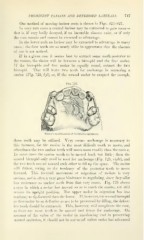Page 749 - My FlipBook
P. 749
—
PROMINENT CANINES AND DEPRESSED LATERALS. 747
One method of moving incisor roots is shown in Figs. 823-827.
In very rare oases a central incisor may be extracted to gain room
that is, if very badly decayed, if an incnrable abscess exist, or if only
the root remain and cannot be crowned to advantage.
In the lower arch an incisor may be extracted to advantage in many
cases ; the four teeth are so nearly alike in appearance that the absence
of one is not noticed.
If in a given case it seems best to extract some tooth posterior to
the canine, the choice will be between a bicuspid and the first molar.
If the bicuspids and fii'st molar be equally sound, extract the first
bicuspid. That will leave tw^o teeth for anchorage in retracting a
canine (Fig. 725, left), or, if the second molar be erupted far enough,
Fig. 725.
\\ I It r - modification of Guilford's appliance.
three teeth may be utilized. Very secure anchorage is necessary in
this instance, for the canine is the most difficult tooth to move, and
oftentimes the two anchor teeth will move more readily than the canine.
In some cases the canine needs to be moved back but little ; then the
second bicuspid only need be used for anchorage (Fig. 725, right), and
the two teeth moved toward each other to fill up the space. The molar
will follow, owing to the tendency of the posterior teeth to move
forward. This forward movement or migration of molars is very
curious, and is often a very great hindrance in regulating, since they offer
less resistance as anchor teeth from that very cause. Fig. 728 shows
a case in which a molar has moved so as to touch the canine, yet still
retains its upright position. The upper molar in migration has less
tendency to tip forward than the lower. If, however, the second bicuspid
or first molar be so defective as not to be preserved by filling, the defect-
ive tooth should be extracted. This, however, will complicate the case,
as there are more teeth to be moved and fewer for anchorage. On
account of the value of the molar in masticating and in preserving
normal occlusion, it should not be extracted unless caries has advanced
PROMINENT CANINES AND DEPRESSED LATERALS. 747
One method of moving incisor roots is shown in Figs. 823-827.
In very rare oases a central incisor may be extracted to gain room
that is, if very badly decayed, if an incnrable abscess exist, or if only
the root remain and cannot be crowned to advantage.
In the lower arch an incisor may be extracted to advantage in many
cases ; the four teeth are so nearly alike in appearance that the absence
of one is not noticed.
If in a given case it seems best to extract some tooth posterior to
the canine, the choice will be between a bicuspid and the first molar.
If the bicuspids and fii'st molar be equally sound, extract the first
bicuspid. That will leave tw^o teeth for anchorage in retracting a
canine (Fig. 725, left), or, if the second molar be erupted far enough,
Fig. 725.
\\ I It r - modification of Guilford's appliance.
three teeth may be utilized. Very secure anchorage is necessary in
this instance, for the canine is the most difficult tooth to move, and
oftentimes the two anchor teeth will move more readily than the canine.
In some cases the canine needs to be moved back but little ; then the
second bicuspid only need be used for anchorage (Fig. 725, right), and
the two teeth moved toward each other to fill up the space. The molar
will follow, owing to the tendency of the posterior teeth to move
forward. This forward movement or migration of molars is very
curious, and is often a very great hindrance in regulating, since they offer
less resistance as anchor teeth from that very cause. Fig. 728 shows
a case in which a molar has moved so as to touch the canine, yet still
retains its upright position. The upper molar in migration has less
tendency to tip forward than the lower. If, however, the second bicuspid
or first molar be so defective as not to be preserved by filling, the defect-
ive tooth should be extracted. This, however, will complicate the case,
as there are more teeth to be moved and fewer for anchorage. On
account of the value of the molar in masticating and in preserving
normal occlusion, it should not be extracted unless caries has advanced


